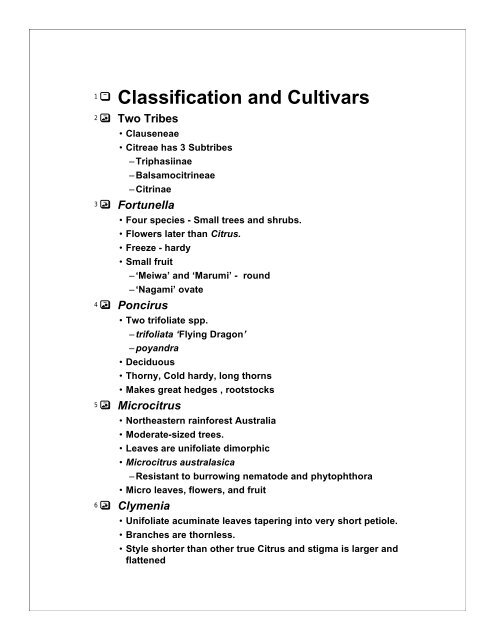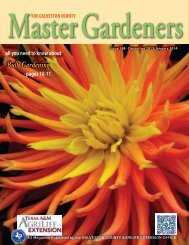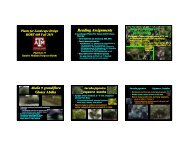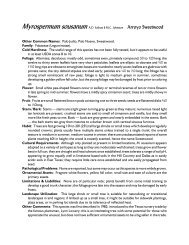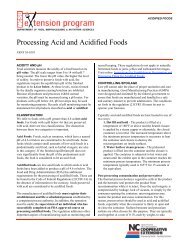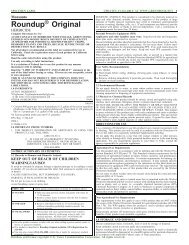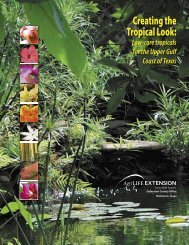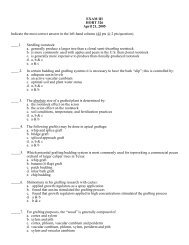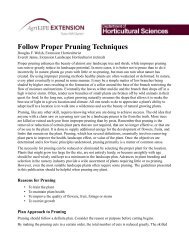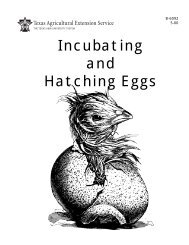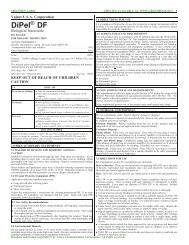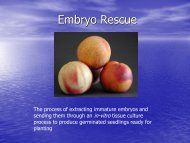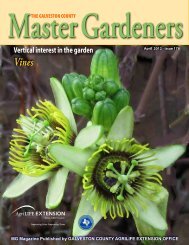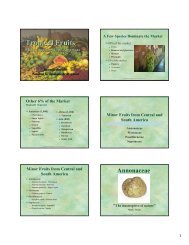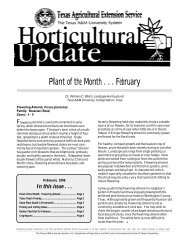Classification and Cultivars - Aggie Horticulture
Classification and Cultivars - Aggie Horticulture
Classification and Cultivars - Aggie Horticulture
Create successful ePaper yourself
Turn your PDF publications into a flip-book with our unique Google optimized e-Paper software.
1 <strong>Classification</strong> <strong>and</strong> <strong>Cultivars</strong><br />
2 Two Tribes<br />
• Clauseneae<br />
• Citreae has 3 Subtribes<br />
–Triphasiinae<br />
–Balsamocitrineae<br />
–Citrinae<br />
3 Fortunella<br />
• Four species - Small trees <strong>and</strong> shrubs.<br />
• Flowers later than Citrus.<br />
• Freeze - hardy<br />
• Small fruit<br />
–‘Meiwa’ <strong>and</strong> ‘Marumi’ - round<br />
–‘Nagami’ ovate<br />
4 Poncirus<br />
• Two trifoliate spp.<br />
–trifoliata ‘Flying Dragon’<br />
–poy<strong>and</strong>ra<br />
• Deciduous<br />
• Thorny, Cold hardy, long thorns<br />
• Makes great hedges , rootstocks<br />
5 Microcitrus<br />
• Northeastern rainforest Australia<br />
• Moderate-sized trees.<br />
• Leaves are unifoliate dimorphic<br />
• Microcitrus australasica<br />
–Resistant to burrowing nematode <strong>and</strong> phytophthora<br />
• Micro leaves, flowers, <strong>and</strong> fruit<br />
6 Clymenia<br />
• Unifoliate acuminate leaves tapering into very short petiole.<br />
• Branches are thornless.<br />
• Style shorter than other true Citrus <strong>and</strong> stigma is larger <strong>and</strong><br />
flattened
• Fruit - ovoid, thin peeled, many oil gl<strong>and</strong>s, many small seeds.<br />
7 Eremocitrus<br />
• Xerophytic native of Australia<br />
• Spreading long drooping branches<br />
• Leaves unifoliate, greyish green, thick, leatherly, <strong>and</strong><br />
lanceolate.<br />
• Sunken stomata, freeze hardy<br />
• Ideal xeroscape plant.<br />
8 Citrus - Subgenus Eucitrus<br />
• Vesicles - no acrid or bitter oil<br />
• C. medica (Citrons)<br />
–Uses - c<strong>and</strong>ied peel,<br />
• Jewish ceremony<br />
• Exocortis indicator<br />
9 Citrus limon (Lemons)<br />
• Commerce<br />
–‘Lisbon’ <strong>and</strong> ‘Eureka’<br />
• Dooryard<br />
–Meyer (Lemon hybrid)<br />
• Rough Lemon<br />
–Rootstock<br />
10 Lemon Hybrids<br />
• Lemonage (lemon x sweet orange)<br />
• Lemonime (lemon x lime)<br />
• Lem<strong>and</strong>rin (lemon x m<strong>and</strong>arin)<br />
• Eremolemon (Eremocitrus x lemon) - Australian Desert Lemon<br />
11 Citrus aurantifolia (Limes)<br />
• ‘Key’ or ‘Mexican’ limes<br />
• ‘Tahiti’ or ‘Persian’ limes some are triploids <strong>and</strong> seedless<br />
• C. macrophylla (lime-like fruit)<br />
–Rootstock in California<br />
• Lemonimes (lime x lemon)<br />
• Limequats (lime x kumquat)
12<br />
• Not grown either in Tahiti or Persian (Iran)<br />
• Seedless <strong>and</strong> marketed when still dark green<br />
13 C. aurantium - Sour Orange<br />
14<br />
• ‘Seville’ in Southern Europe<br />
–Orange marmalade<br />
• ‘Bouquet’ & ‘Bergamot’<br />
• - Italy<br />
–Essential oil<br />
• Many forms like ‘Bittersweet’<br />
–Rootstock - High quality fruit.<br />
15 C. sinensis - Sweet Orange<br />
• Round oranges<br />
–‘Valencia’ -Worlds most imp.<br />
–‘Parson Brown’, ‘Hamlin’, ‘Pineapple’ - US<br />
–‘Shamouti’ - Israel<br />
–‘Cadenera’ - Spain<br />
–‘Pera’ - Brazil<br />
16 C. sinensis - Navel Oranges<br />
• Secondary fruit - easy ID<br />
• Fresh fruit - Gift packs<br />
• Lower acid thus sweeter taste<br />
• Limonin in juice can be removed<br />
• Environmental stresses<br />
• Best quality in cooler climates<br />
17 California Navel Oranges<br />
• ‘Washington’ most widely grown<br />
–Old line replaced by nucellars<br />
• ‘Atwood’, ‘Fisher’, ‘Newhall’ are earliest navels<br />
• ‘Lane Late’ - late maturing, fruit hold well on tree.<br />
18 Spanish Navels<br />
• ‘Navelina’ sport of ‘Washington’ at Riverside, CA - 1910
–Early season, smaller tree, <strong>and</strong> holds well on tree.<br />
• ‘Navelate’ sort of ‘Washington’ late maturing - vigorous tree.<br />
19 Texas Navels<br />
• ‘Washington’ - most widely planted navel in world<br />
• ‘Marrs’ - limb sport of ‘Washington’ lacks distinct secondary<br />
fruit.<br />
• Early maturing, low acid.<br />
• Lower in limonin.<br />
20 Florida Navels<br />
• ‘Summerfield’ early maturing - adapted to humid climate.<br />
• Nucellar selection - F-56-11 most widely used in new plantings.<br />
21 Brazilian Navels<br />
• ‘Baianinha’ - ‘Bahia’ limb sport<br />
–Less vigorous <strong>and</strong> smaller secondary fruit, thus<br />
• Less prone to fruit drop<br />
• Adapted to hot, arid climate<br />
22 Australian Navels<br />
• ‘Leng’ major navel orange<br />
–‘Washington’ sport - 1934<br />
–Small size, thinner peel.<br />
• ‘Lane Late’ - late season but subject to regreening <strong>and</strong><br />
granulation.<br />
23 South African Navels<br />
• South Africa<br />
–‘Palmer’ nucellar seedling of ‘Washington’ - 1930s<br />
• Vigorous, productive, hold well on tree<br />
–‘Robyn’ - cooler location<br />
24 Venezuelan Navels<br />
• ‘Cara Cara’<br />
–Red flesh even in lowl<strong>and</strong> tropics (uncharacteristic of blood<br />
oranges)<br />
25 Pigmented Oranges<br />
• Grown in Mediterranean climates with hot days <strong>and</strong> cool nights.
• Anthocyanin pigment rather than<br />
– lycopene as in grapefruit<br />
– carotenoid as in oranges<br />
• ‘Tarocco’, ‘Sanguinello’, ‘Maltaise<br />
26 Acidless or Sugar oranges<br />
• Low acid levels<br />
• Therapeutic properties<br />
• Succari-Egypt<br />
• Mosambi-East African/Portuguese<br />
27 C. sinensis Hybrids<br />
• Citranges (sweet x trifoliate)<br />
• Citrangors (sweet x citrange)<br />
• Citrangequats (citrange x kumquat)<br />
• Citrangeremos (citrange x Euremocitrus)<br />
28 Citrus reticulata<br />
• Satsuma group<br />
–Primarily grown in Japan<br />
–Important in Louisiana <strong>and</strong> for dooryard in Gulf Coast<br />
• Tangerine group<br />
–Commercial in Fla. - ‘Dancy’ <strong>and</strong> ‘Clementine’ -deep orange<br />
29 Dancy Tangerine<br />
• Production problems<br />
• alternate bearing<br />
• Susceptible to Alternaria<br />
30 Swingle <strong>and</strong> Tanaka Differ<br />
• Satsuma<br />
–C. reticulata - C. unshiu<br />
• ‘Dancy’<br />
–C. reticulata - C. tangerina<br />
• ‘Cleopatra’<br />
–C. reticulata - C. reshni<br />
31 More differences
• ‘King’<br />
–tangor? C. noblis<br />
• ‘Temple’<br />
–tangor? C. temple<br />
• ‘Calamondin’<br />
–(C. reticulata x C. ichangensis)<br />
• C. madurensis<br />
32 Breeder’s Delight<br />
33<br />
• ‘Clementine’ <strong>and</strong> ‘Temple’ produce only monoembryonic seeds.<br />
• No nucellars.<br />
Temple Orange<br />
• Named after W.C. Temple from FL.<br />
• Hybrid of m<strong>and</strong>arin <strong>and</strong> orange<br />
34 Murcott or Honey Tangerine<br />
35<br />
2 • It is hybrid of unknown parentage<br />
• Fruits are borne terminally so they are vulnerable to wind.<br />
Ponkan (Chinese Honey orange, Nagpur Santra)<br />
• Widely grown m<strong>and</strong>arin in the world<br />
• Alternate bearing<br />
36 Tangerine x Grapefruit<br />
• ‘Orl<strong>and</strong>o’ tangelo<br />
• ‘Minneola’ tangelo<br />
• ‘Page’ orange<br />
• ‘Robinson’ tangerine<br />
• ‘Nova’ tangelo<br />
• ‘Ugli’ tangelo<br />
37 Tangelos<br />
• Commercial - ‘Orl<strong>and</strong>o’ <strong>and</strong> ‘Minneola’<br />
–‘ Dancy’ x ‘Duncan’<br />
• Vigorous
• Freeze hardy<br />
• Weakly parthenocarpic<br />
38 Tangelos Continued<br />
39<br />
• Fruit set by either<br />
–Cross pollination<br />
–GA3<br />
• Which would be best for fresh market?<br />
Orl<strong>and</strong>o tangelo<br />
• Duncan grapefruit x Dancy tangerine<br />
• leaves cup-shaped<br />
• seedy<br />
40 Orl<strong>and</strong>o<br />
• Most cold hardy of all comm. citrus except satsuma.<br />
• Oblate to subglobose<br />
• Seedless to 10 - 20 seeds<br />
• + correlation between fruit size <strong>and</strong> seed number.<br />
• Harvest between Dec - Jan NH<br />
41 Orl<strong>and</strong>o Continued<br />
• Pollinators<br />
–‘Temple’<br />
–‘Robinson’<br />
• More Nitrogen required than for round oranges because tree is<br />
more vigorous.<br />
42 Minneola Tangelo<br />
2 • Duncan x Dancy<br />
• Cold-resistant<br />
• Distinct flavor being rich (from Dancy) <strong>and</strong> tart from Duncan).<br />
43 Minneola<br />
• Vigorous tree
• Tree - large <strong>and</strong> spreading<br />
• Leaves - large, pointed laminae<br />
• Petioles - moderate size<br />
• Fruit - large obovate with neck<br />
• Color - Deep reddish orange.<br />
44 Minneola Continued<br />
• Juice flavor - excellent<br />
• Peel moderately adherent - finely pebbled<br />
• Seed 0 - 20<br />
• Matures - Jan to March - NH<br />
–July to August - SH<br />
45 Minneola Continued<br />
46<br />
47<br />
• Pollinators are ‘Temple’ <strong>and</strong> ‘Robinson’<br />
• ‘Orl<strong>and</strong>o’ will not pollinate ‘Minneola’<br />
• Large solid blocks set seedless fruits with GA3<br />
2 Nova (Clemenvilla, Suntina)<br />
• Fina Clementine x Orl<strong>and</strong>o tangelo<br />
• Seedless when grown apart from pollinating varieties<br />
• Spain <strong>and</strong> Israel<br />
Page<br />
• Minneola x Clementine<br />
• Sensitive to Bromacil<br />
• Usually referred to as ‘orange’


